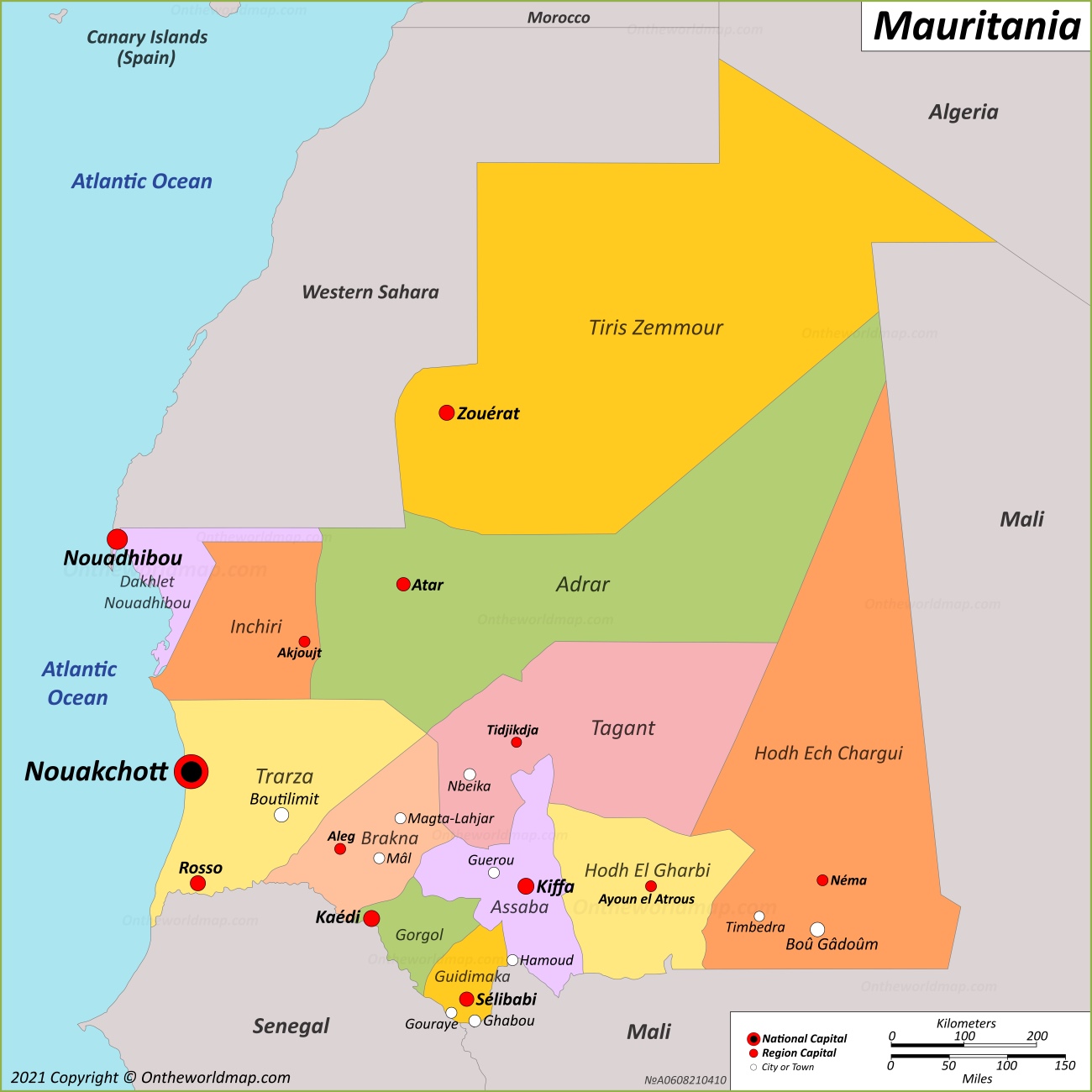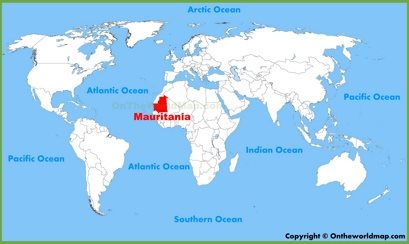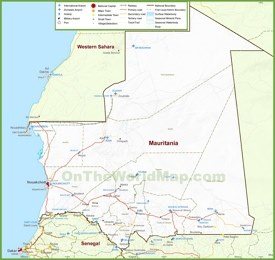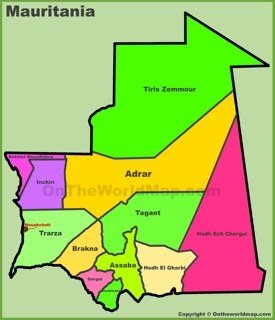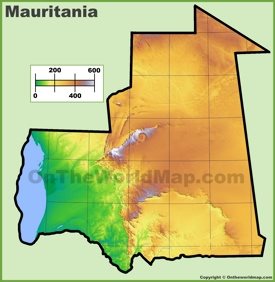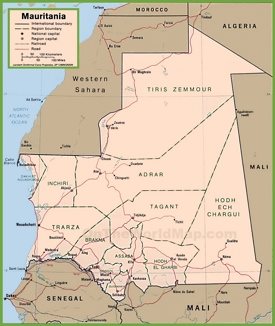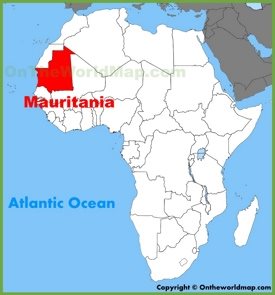Mauritania Map
Description:
This map shows governmental boundaries of countries, region boundaries, regions, region capital cities, major cities and towns in Mauritania.
Size: 1300x1300px / 253 Kb
Author: Ontheworldmap.com
You may download, print or use the above map for educational, personal and non-commercial purposes. Attribution is required. For any website, blog, scientific research or e-book, you must place a hyperlink (to this page) with an attribution next to the image used.
Online Map of Mauritania
Detailed Maps of Mauritania
About Mauritania
Mauritania is located in northwestern Africa and covers an area of about 400,000 square miles (1,036,000 square kilometers). It is bordered by Western Sahara to the north, Algeria to the northeast, Mali to the east and southeast, Senegal to the southwest, and the Atlantic Ocean to the west. The country has a population of about 4.5 million.
Nouakchott, the capital and largest city, serves as the political and economic center, housing government offices and major infrastructure. Other significant cities include Nouadhibou, a major port and commercial center, and Kaedi, known for its agricultural activities.
Mauritania's economy relies heavily on natural resources, especially iron ore, which makes up a large part of its exports. Fishing and agriculture also play an important role, and the Senegal River Valley contributes to crop production.
The country faces challenges such as poverty, unemployment and infrastructure development. Efforts to diversify the economy include investments in mining, renewable energy, and increasing agricultural productivity. Despite these challenges, Mauritania continues to utilize its resource wealth and strategic location to stimulate economic growth and development.
The Facts:
| Capital: | Nouakchott |
| Area: | 400,000 sq mi (1,036,000 sq km) |
| Population (2024): | ~ 4,330,000 |
| Official language: | Arabic |
| Currency: | Ouguiya (MRU) |
| Driving side: | right |
| Calling code: | +222 |
| Internet TLD: | .mr |
| Time zone: | UTC (GMT) |
| Gross domestic product 2023 (PPP): |
|
| Gross domestic product 2023 (nominal): |
|
Largest Cities: Nouakchott, Nouadhibou, Kiffa, Kaédi, Zouérat, Rosso, Sélibabi, Boû Gâdoûm, Boutilimit, Atar, Bareina, Ghabou, Hamoud, Mâl, Nbeika, Gouraye, Timbedra, Magta-Lahjar, Guerou.
Regions of Mauritania: Adrar, Assaba, Brakna, Dakhlet Nouadhibou, Gorgol, Guidimaka, Hodh Ech Chargui, Hodh El Gharbi, Inchiri, Nouakchott-Nord, Nouakchott-Ouest, Nouakchott-Sud, Tagant, Tiris Zemmour, Trarza.
Departments of Mauritania: Atar, Chinguetti, Oujeft, Ouadane, Aftout, Boumdeid, Guerou, Kankossa, Kiffa, Aleg, Bababe, Bogué, M'Bagne, Magtar Lahjar, Nouadhibou, Kaedi, M'Bout, Maghama, Monguel, Ould Yenge, Sélibaby, Amourj, Bassikounou, Djigueni, Néma, Oualata, Timbedra, Ayoun el Atrous, Kobenni, Tamchekket, Tintane, Akjoujt, Dar-Naim, Teyarett, Toujouonine, Ksar, Sebkha, Tevragh-Zeina, Arafat, El Mina, Riyad, Moudjeria, Tichit, Tidjikja, Bir Moghrein, Fderîck, Zouérat, Boutilimit, Keur Massene, Mederdra, Ouad Naga, R'Kiz, Rosso.
Geography of Mauritania
Mauritania's geography is characterized by vast desert landscapes and diverse ecological regions. The northern and central parts of the country are dominated by the Sahara Desert with sand dunes, rocky plateaus, and sparse vegetation. In contrast, the southern region, part of the Sahel, consists of semi-arid grasslands and supports limited agriculture and pastoralism.
The climate varies from arid in the north to semiarid in the south, with temperatures ranging from 25 to 45°C (77-133°F) during the summer months. Rainfall is infrequent and irregular, mainly from July to September in the southern regions.
The Senegal River forms the southern border with Senegal, providing a vital source of water for agriculture and the livelihoods of local communities. Mauritania's geographic diversity influences its economic activities, with mining and agriculture playing key roles in different regions.
Brief History of Mauritania
Mauritania's history reflects a mixture of Berber, Arab and African influences. In the eighth century, the Ghana Empire emerged in the region, followed in the eleventh century by the Almoravid movement, which spread Islam throughout West Africa. By the 15th century, European explorers began arriving here, leading to increased trade and contact.
In the late 19th century, France colonized Mauritania, incorporating it into French West Africa. In 1960, Mauritania gained independence and became a republic. Since independence, the country has experienced periods of political instability, including coups and military rule, but efforts are underway to establish democratic rule.

